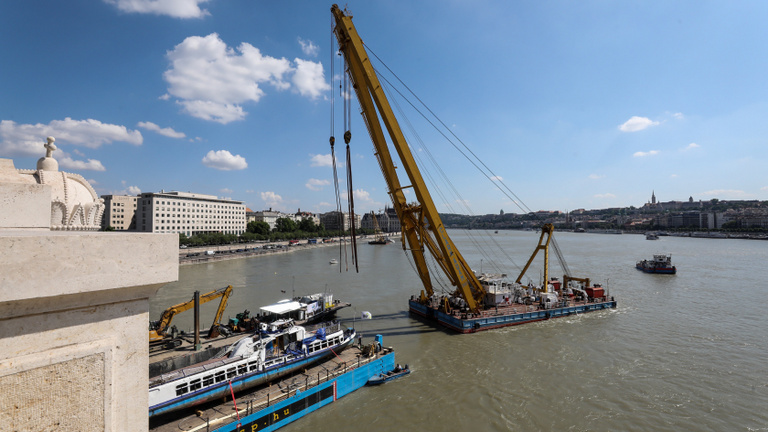
The Hableány was lifted from the Danube
-
Hungarian newswire MTI reports that four bodies have been lifted from the Hableány until 8:20 AM. Rescuers are still looking for four missing victims.
-
-
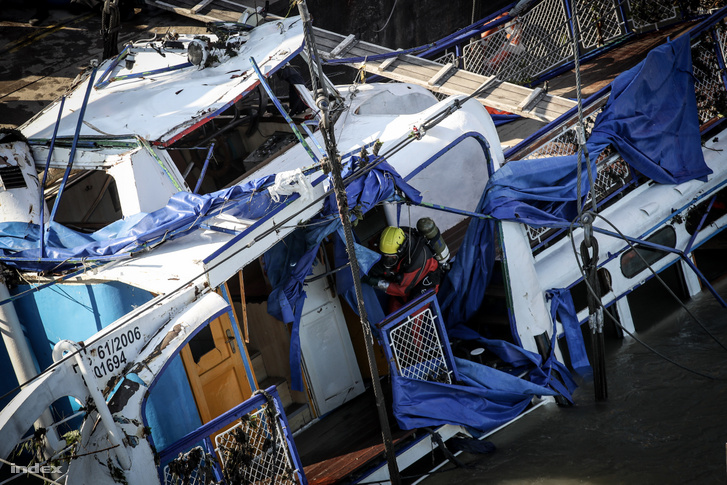 IndexFotó: Huszti István /
IndexFotó: Huszti István /Our colleague on location has reported that three bodies were retrieved from the wreckage until 8:00 AM. The boat is higher up already, and South Korean divers are now searching through the Hableány's cabin where most victims are presumed to have been at the time of the accident.
-
The authorities are prepared to soak up any fuel that might leak from the Hableány, as her hull contains 1400 litres of gasoline, Hungarian newswire MTI reported.
-
 Index Huszti István /Fotó: Fotó:
Index Huszti István /Fotó: Fotó:The lifting continues. After the bridge, rescuers are now looking through the restrooms and the staircase leading to the engine room. The Hableány will be lifted in four phases: First, the boat was lifted until the bridge surfaced. The crane is now going to lift the boat until the boat's cabin is out of the water, and after the divers search the cabin, the Hableány will be raised until her waterline, before finally being lifted out of the water onto the blue barge anchored next to the Clark Ádám crane vessel.
-
As planned, rescuers stopped raising the Hableány after the bridge surfaced, so a diver could explore the area where the captain was during the accident.
Our colleague on location reported that a body was recovered from the bridge of the Hableány. The body was already placed onto the rescue boat anchored nearby. The Hungarian authorities requested journalists to suspend live video coverage out of respect for the victims. -
A diver could be seen putting on his oxigen bottles on the live coverage of M1 preparing to enter the Hableány's bridge, rescue workers are currently pumping water out from the hull. The wreckage is not level yet, it's leaning towards the Pest bank of the Danube.
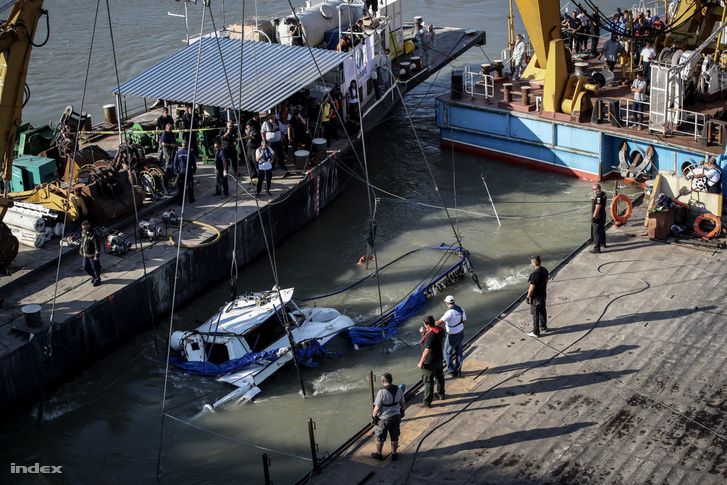 Fotó: Huszti István / Index
Fotó: Huszti István / Index -
The live coverage of M1 showed the roof of the Hableány's bridge at the surface.
It seems that the boat could be lifted with the hull intact. Rescuers are soon to start pumping the water out of the boat.
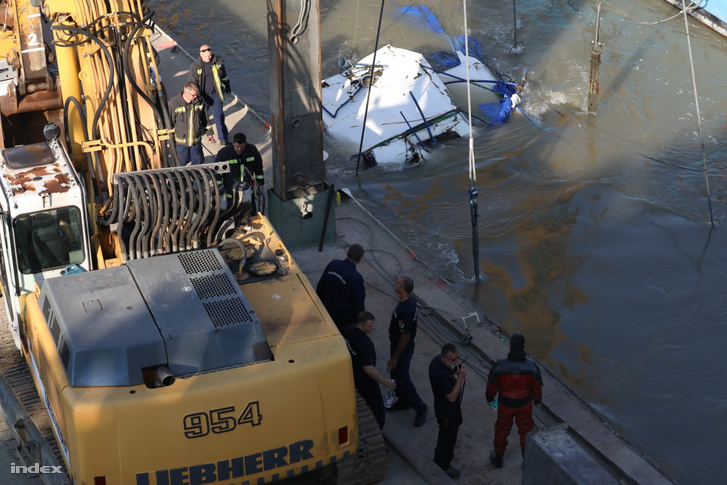 Fotó: Ajpek Orsi / Index
Fotó: Ajpek Orsi / Index -
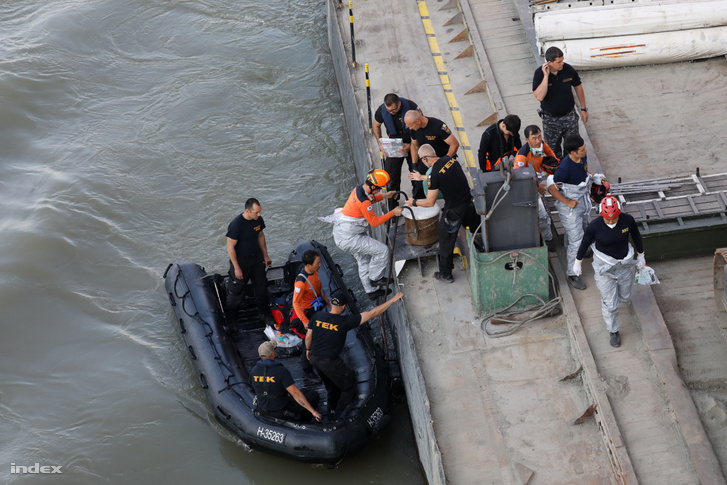 Fotó: Ajpek Orsi / Index
Fotó: Ajpek Orsi / Index -
Eleven people are working on the Clark Ádám crane vessel, as the reporter of M1 just told viewers. The reporter standing on Margit bridge added that he heard the cables of the Clark Ádám creak, meaning that the lifting has started, but that operation is painstakingly slow - rescuers have to raise the Hableány millimetre by millimetre to make sure that the hull does not break, as bodies of victims are still likely to be found in the hull.
-
The 50-ton Hableány was built in 1949, it is 27.2 metres long, 4.8 metres wide, and 5.2 metres tall. The sightseeing boat was regularly maintained prior to the accident and had no apparent mechanical or structural failures. The latest sonar images shown on Hungarian state news channel M1 reveal that the Hableány is currently in a more-or-less upright position.
Rescuers will employ four lifting slings to make sure that the Hableány remains intact as it is lifted from the river, but as TEK's press officer reminded everyone at the press conference held on Monday, anything can happen as the boat is 70 years old, and nobody knows what sort of injuries the hull could have sustained.
-
The press officer of the Hungarian Counter Terrorism Centre that coordinates the rescue effort, Nándor Jasenszky told journalists on Monday that rescuers will be using the Clark Ádám crane vessel as part of a a four-ship floating establishment to lift the wreckage of the Hableány from the Danube in an operation that could take as long as six hours.
There is no exact time for when the lifting will commence. There are four lifting slings that had to be put under the Hableány, which were in place and have already been checked on Monday afternoon, but Jasenszky said a final check will be necessary after the floating establishment has been set up by Tuesday morning.
The Hableány will be lifted from the Danube slowly, in multiple phases. The first phase is the most critical: Rescuers will be raising the boat slowly until it breaks away from the riverbed to see the condition of the hull. As Jasenszky put it: "If anything were to happen, it could happen at this point."
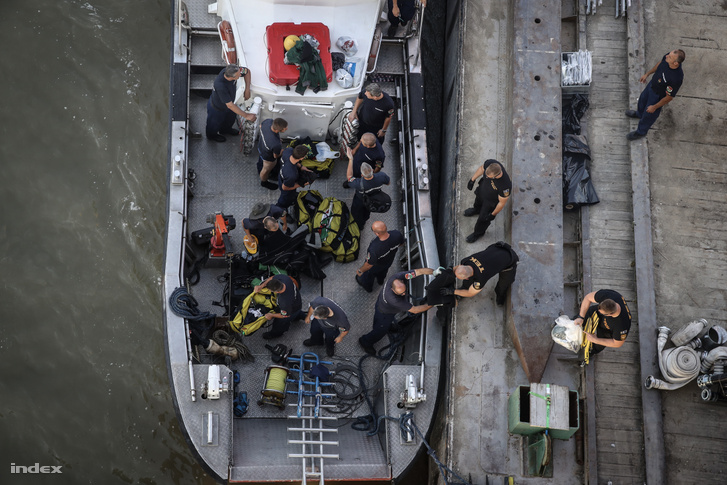 Fotó: Huszti István / Index
Fotó: Huszti István / IndexAfter this, the rescue team is going to look through the boat searching for any possible victims still in the hull. If divers find any bodies, they will retrieve them from the wreckage before the water can be pumped out of the Hableány. If the hull can be lifted from the water without breaking, it will be placed on the barge anchored next to the Clark Ádám crane vessel.
Read our article answering some of the frequently asked questions concerning the recovery operation:
-
Watch our live stream from the location of the accident:
-
A 60-member detective team is working on investigating the causes leading to the crash of the Hableány and Viking Sigyn as a statement released by the Hungarian Police on Monday informs. Right after the accident, police officers breathalysed the C. Yuriy, 64-year old Ukrainian captain of the Viking Sigyn, seized his telecommunication devices (though according to the prosecution, the captain deleted data from his phone after the accident), and data carriers of the Sigyn containing the ship's recorded radar screens, radio communication, and AIS data. Police have questioned passengers of Viking Sigyn and interrogated the captain after he was taken into custody.
Police have since arrested C. Yuriy under the suspicion that he criminally endangered the safety of water transport causing a deadly mass catastrophe. According to the statement of the Police, C. Yuriy is yet to make a comprehensive testimony.
The Viking Sigyn left port two days after the accident and continued its scheduled trip to Passau, Germany. Police at the time said they have taken all steps onboard the Sigyn that was necessary for the investigation which is why it could have been released, yet South Korean officials demanded the ship to be seized. Since then, the Sigyn is once again in Hungary, and authorities have conducted another search to find more evidence on it in Visegrád on Monday.
-
There were 35 people onboard the Hableány at the time of the accident, the two-member Hungarian crew and 33 South Korean citizens - a tourist group mostly comprised of families and two tour guides.
Seven people, all of them South Korean citizens, have survived the accident.
The bodies of the first seven victims were found on the night of the crash, and rescue teams started looking for the 21 missing people on the entire Hungarian section of the Danube south of Budapest. 13 more victims, including one of the crewmembers, were found so far, bringing the death toll of the tragic accident to 20, with eight people still unaccounted for.
-
On Wednesday 29 May 2019, at 9:05 PM, the 135-metre, the 1000-ton river cruise ship Viking Sygin rammed the rear of the 40-ton, 27-metre sightseeing boat Hableány (Mermaid) as they were heading North and passing under Margit bridge. This caused the Hableány to capsize and disappear under the Sigyn within seconds with 35 people onboard: 31 South Korean tourists, their two tour guides, and the 2-member Hungarian crew of the Hableány. The bodies of seven South Korean citizens were found on the night of the accident, and the seven survivors - all of them South Koreans - were picked up by civilian boats. Sigyn has immediately moored at the Carl Lutz quay after passing under the bridge.
Police have released the following CCTV footage of the accident on the following morning:
-
Rescue teams are planning to lift the remains of the Hableány from the Danube on Tuesday morning. The sightseeing boat was involved in the tragic accident on 29 May and sank within a matter of seconds after river cruiser Viking Sigyn hit the Hableány just as they were about to pass under Margit bridge heading North.
The rescue teams' efforts were hampered by the water levels of the flooding Danube, and the unusually low visibility and strong currents of the swollen river made even worse by the location of the accident being so near to the pillars of Margit bridge.
The 50-ton hull of the Hableány will be lifted by the Clark Ádám crane vessel that with a nominal lifting capacity of 200 tons is the strongest such machine in Hungary. The Clark Ádám arrived at the scene on Friday, as water levels before were to high for the floating crane to pass under the bridges spanning over the Danube.